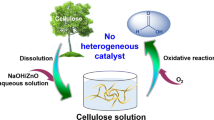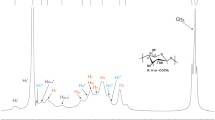Abstract
1,2,3,4-Butanetetracarboxylic acid (BTCA) reacts with cellulose in two steps: anhydride formation of adjacent carboxyl groups in BTCA and esterification of anhydride with cellulose, which are generally catalyzed by alkaline salts including sodium hypophosphite. The role of the salts in the reactions has been unclear. As an effort in fully understanding the catalytic effects of the salts, reaction mechanisms of alkaline metal ions and acid anions of the salts were investigated in details in the reactions. In this research, functions of alkaline metal ions on the formation of anhydride were studied. Results indicated that the existence of lithium, sodium or potassium promoted the formation of anhydride, and potassium ion was the most efficient one among these three ions. Besides, the reactions of a BTCA molecule with cellulose undergo a step-by-step process, i.e. formation of one anhydride and esterification of the anhydride with cellulose, and then formation of another anhydride and esterification of it to establish cross-linking by the BTCA.






Similar content being viewed by others
References
Andrews BK, Morris NM (1993) Alkali metal salts of hydroxy acids as catalysts in durable press finishing with butanetetracarboxylic acid. J Text Inst 84(4):631–637
Gu X, Yang CQ (1998) FT-IR and FT-Raman spectroscopy study of the cyclic anhydride intermediates for esterification of cellulose: I. Formation of anhydrides without a catalyst. Res Chem Intermed 24(9):979–996
Hou A, Sun G (2013) Multifunctional finishing of cotton fabrics with 3,3′,4,4′-benzophenone tetracarboxylic dianhydride: reaction mechanism. Carbohydr Polym 95:768–772
Krest’yaninov M, Titova A, Zaichikov A (2014) Intra- and intermolecular hydrogen bonds in ethylene glycol, monoethanolamine and ethylenediamine. Russ J Phys Chem A+ 88(12):2114–2120
Laemmermann D (1993) New possibilities for non-formaldehyde finishing of cellulosic fibers. Melliand Texilber 73(3):105–107
Lam YL, Kan CW, Yuen CWM (2011) Physical and chemical analysis of plasma-treated cotton fabric subjected to wrinkle-resistant finishing. Cellulose 18:493–503
Morris NM, Catalano EA, Andrews BK (1995) FT-IR determination of degree of esterification in polycarboxylic acid cross-link finishing of cotton. Cellulose 2:31–39
Morris CE, Morris NM, Trask-Morrell BJ (1996) Interaction of meso-1,2,3,4-butanetetra- carboxylic acid with phosphorus-containing catalysts for esterification cross-linking of cellulose. Ind Eng Chem Res 35(3):950–953
Ning YC (2000) Structural identification of organic compounds and organic spectroscopy, 2nd edn. Science Press, Beijing, pp 493–494
Ramnial T, Jong H, McKenzie ID (2003) An imidazol-2-ylidene borane complex exhibiting inter-molecular [C–Hδ+ Hδ–B] dihydrogen bonds. Chem Commun 14:1722–1723
Rowland SP, Brannan AF (1968) Mobile ester cross links for thermal creasing of wrinkle-resistant cotton fabrics. Text Res J 38(6):634–643
Shannon RT (1976) Revised effective ionic radii and systematic studies of interatomic distances in halides and chalcogenides. Acta Crystallogr A 32(5):751–767
Wei W, Yang CQ (1999) Predicting the performance of durable press finished cotton fabric with infrared spectroscopy. Text Res J 69(2):145–151
Welch CM (1988) Tetracarboxylic acids as formaldehyde-free durable press finishing agents. Part I: catalyst, additive, and durability studies. Text Res J 58(8):480–486
Welch CM (1992) Formaldehyde-free durable-press finishes. Rev Prog Color 22(1):32–41
Welch CM, Andrews BK (1990) Catalysts and processes for formaldehyde-free durable press finishing of cotton textiles with polycarboxylic acids. US Patent, 4,936,865
Yang CQ (1991a) FT-IR spectroscopy study of the ester crosslinking mechanism of cotton cellulose. Text Res J 61(8):433–440
Yang CQ (1991b) Characterizing ester crosslinkages in cotton cellulose with FT-IR photoacoustic spectroscopy. Text Res J 61(5):298–305
Yang CQ (1993) Effect of pH on nonformaldehyde durable press finishing of cotton fabric: FT-IR spectroscopy study. Part I: Ester crosslinking. Text Res J 63(7):420–430
Yang CQ (2001) FTIR spectroscopy study of ester crosslinking of cotton cellulose catalyzed by sodium hypophosphite. Text Res J 71(3):201–206
Yang CQ, Wang X (1998) Formation of five-membered cyclic anhydride intermediates by polycarboxylic acids: thermal analysis and Fourier convert infrared spectroscopy. J Appl Polym Sci 70(13):2711–2718
Yao W, Wang B, Ye T, Yang Y (2013) Durable press finishing of cotton fabrics with citric acid: enhancement of whiteness and wrinkle recovery by polyol extenders. Ind Eng Chem Res 52(46):16118–16127
Zhao CY, Sun G (2015) Catalytic actions of sodium salts in direct esterification of 3,3′4,4′-benzophenone tetracarboxylic acid with cellulose. Ind Eng Chem Res ASAP. doi:10.1021/acs.iecr.5b02308
Acknowledgments
This research was funded by the Chinese National Science and Technology Support Program (No. 2012BAE11G00). B. Ji is grateful for the Donghua University Outstanding Graduate Student Scholarship Fund. Cotton Incorporated provided funding for the work at University of California, Davis.
Author information
Authors and Affiliations
Corresponding author
Rights and permissions
About this article
Cite this article
Ji, B., Qi, H., Yan, K. et al. Catalytic actions of alkaline salts in reactions between 1,2,3,4-butanetetracarboxylic acid and cellulose: I. Anhydride formation. Cellulose 23, 259–267 (2016). https://doi.org/10.1007/s10570-015-0810-0
Received:
Accepted:
Published:
Issue Date:
DOI: https://doi.org/10.1007/s10570-015-0810-0




